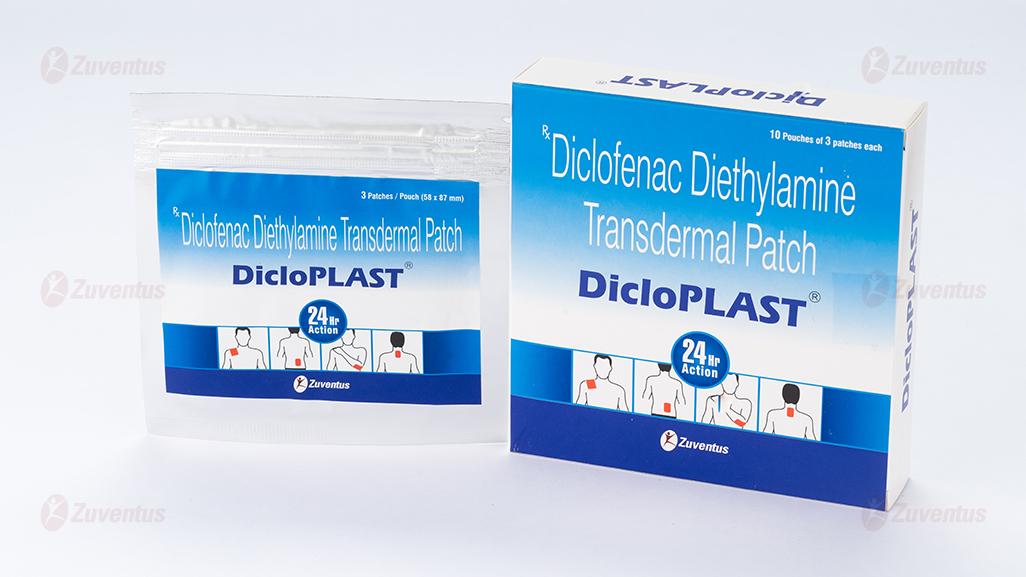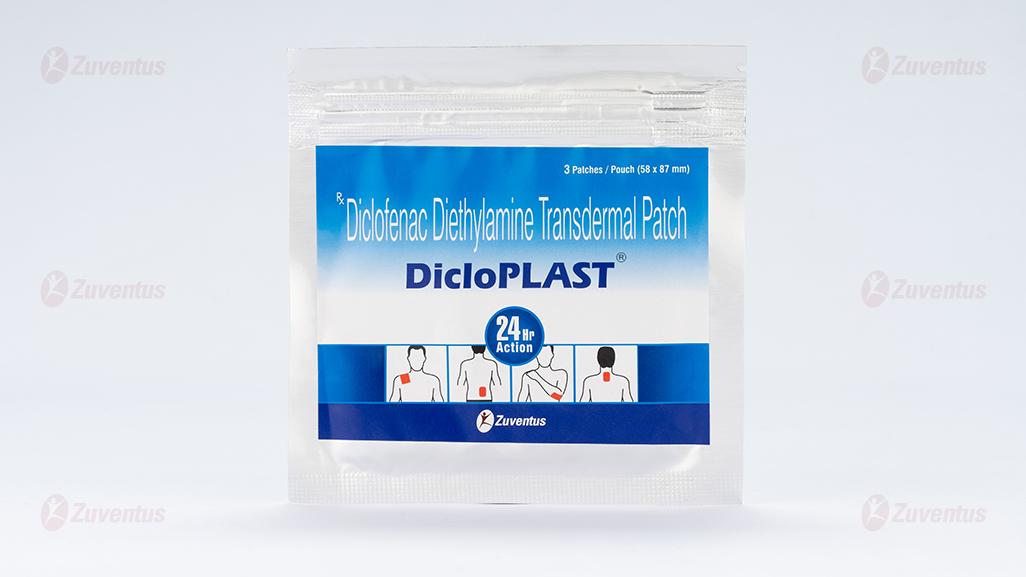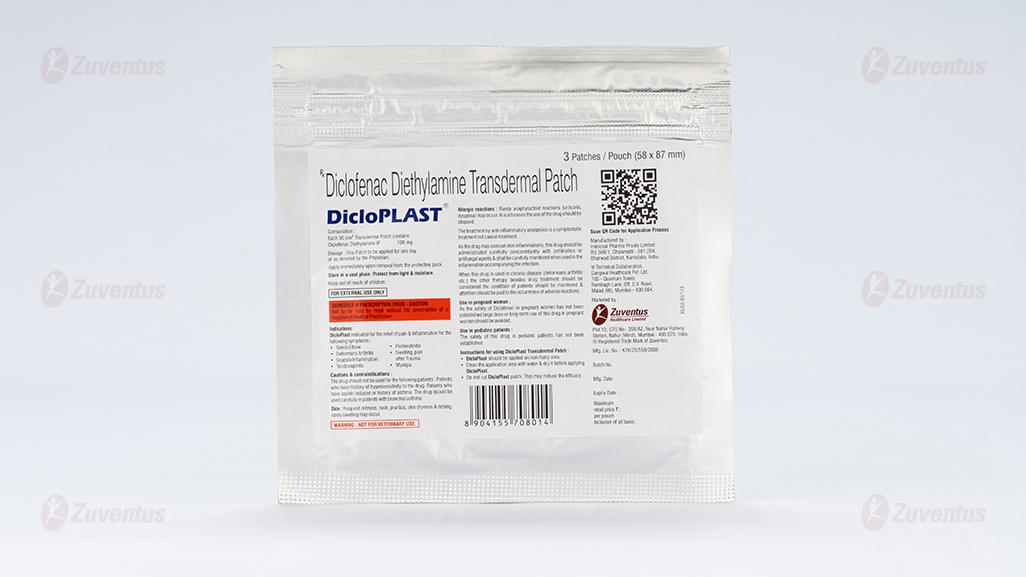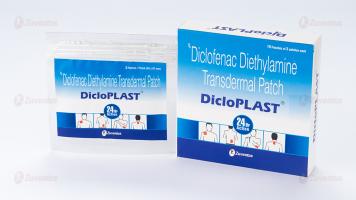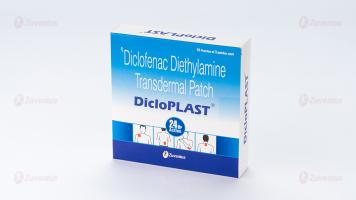Dicloplast
Therapy Area
Pain management
1.0 Generic name
Diclofenac Diethylamine Transdermal Patch
2.0 Qualitative and quantitative composition
Each 50 cm2 Transdermal Patch contains:
Diclofenac Diethylamine IP 100 mg
3.0 Dosage form and strength
Transdermal Patch
Diclofenac Diethylamine 100 mg/50 cm2
FOR EXTERNAL USE ONLY
4.0 Clinical particulars
4.1 Therapeutic indications
DicloPLAST® is indicated for the treatment of mild to moderate pain due to osteoarthritis or soft tissue injury.
4.2 Posology and method of administration
Adults and adolescents from 16 years
One Patch to be applied for one day or as directed by the physician
Duration of use
DicloPLAST® is for short-term treatment. The duration of use should not exceed 7 days. The therapeutic benefit of longer use has not been established.
If there is no improvement, during the recommended duration of treatment or a worsening of symptoms, a doctor should be consulted.
DicloPLAST® is to be used for the shortest duration necessary to control symptoms depending on the indication.
Elderly patients and patients with renal or hepatic impairment
This medication should be used with caution in elderly patients who are more prone to adverse events.
Paediatric population
Safety and effectiveness of DicloPLAST® has not been established in pediatric patients.
Method of administration
Cutaneous (Transdermal) use only.
Instructions for using DicloPlast Transdermal Patch:
- DicloPLAST® should be applied on non-hairy area.
- DicloPLAST® should be applied only to intact non-diseased skin and should not be worn when bathing or showering.
- Clean the application area with water & dry it before applying DicloPLAST®.
- Do not cut DicloPLAST®. This may reduce the efficacy.
- If necessary, the medicated patch can be held in place using a net bandage.
- The DicloPLAST® must not be used together with an occlusive dressing.
4.3 Contraindications
- Hypersensitivity to the active substance or to any of the excipients.
- In patients with hypersensitivity to acetylsalicylic acid or other non-steroidal anti-
- inflammatory drugs [NSAIDs].
- In patients who have previously experienced asthma, angioedema, urticaria or acute rhinitis
- when taking acetylsalicylic acid or any other NSAIDs.
- In patients with active peptic ulcer.
- On damaged skin, whatever the lesion involved: exudative dermatitis, eczema, infected
- lesion, burn or wound.
- During the last trimester of pregnancy.
- Children: The use in children is contraindicated.
4.4 Special warnings and precautions for use
DicloPLAST® must not come into contact with or be applied to the eyes or mucous membranes. It should be applied only to intact non-diseased skin, and not to skin wounds or open injuries. Topical diclofenac can be used with non-occlusive bandages but should not be used with an airtight occlusive dressing. Undesirable effects can be reduced by using the lowest effective dose for the shortest possible period of time. Bronchospasm can occur in patients who suffer or have previously suffered from bronchial asthma or allergies. Treatment must be stopped immediately if a skin rash develops after applying the medicated patches. Patients should be warned against exposure to sunlight or solarium radiation after removal of the DicloPLAST® in order to reduce the risk of photosensitisation. The possibility of systemic adverse events from application of diclofenac medicated patch cannot be excluded if the preparation is used on large areas of skin and over a prolonged period. Although the systemic effects are expected to be minimal, the medicated patch should be used with caution in patients with impaired renal, cardiac or hepatic function, or a history of peptic ulcer, inflammatory bowel disease or haemorrhagic diathesis. Non-steroidal anti-inflammatory drugs should be used with caution in elderly patients as they are more likely to experience undesirable effects. No other medicinal products containing diclofenac or any other non-steroidal anti-inflammatory drugs (NSAIDs) should be used concomitantly, neither topically nor systemically. Paediatric population DicloPLAST® is not recommended for use in children.
4.5 Drug Interactions
Non-steroidal anti-inflammatory drugs may interact with blood pressure lowering drugs, and may possibly enhance the effects of anticoagulants, although the chance of either of these occurring with a topically administered preparation is extremely remote. Concurrent aspirin or other NSAIDs may result in an increased incidence of adverse reactions. Since systemic absorption of diclofenac during labelled use of the DicloPLAST® is very low, the risk of developing clinically relevant drug-drug interactions is negligible.
4.6 Use in special populations
Fertility
There are no data available on the use of topical formulations of diclofenac and its effects on fertility in humans. The systemic concentration of diclofenac is lower after topical administration, compared to oral formulations. As for other NSAIDs, the oral use of diclofenac may impair female fertility and is not recommended in women attempting to conceive.
Pregnancy
As the safety of Diclofenac in pregnant women has not been established large dose or long-term use of this drug in pregnant women should be avoided.
The systemic concentration of diclofenac is lower after topical administration, compared to oral formulations. With reference to experience from treatment with pharmaceutical forms with systemic uptake, the following is recommended:
Inhibition of prostaglandin synthesis may adversely affect the pregnancy and/or the embryo/foetal development. Data from epidemiological studies suggest an increased risk of miscarriage and of cardiac malformation and gastroschisis after use of a prostaglandin synthesis inhibitor in early pregnancy. The absolute risk for cardiovascular malformation was increased from less than 1%, up to approximately 1.5 %. The risk is believed to increase with dose and duration of therapy. In animals, administration of a prostaglandin synthesis inhibitor has been shown to result in increased pre- and post-implantation loss and embryo-foetal lethality. In addition, increased incidences of various malformations, including cardiovascular, have been reported in animals given a prostaglandin synthesis inhibitor during the organogenetic period.
During the first and second trimester of pregnancy, diclofenac should not be given unless clearly necessary. If diclofenac is used by a woman attempting to conceive, or during the first and second trimester of pregnancy, the dose should be kept as low and duration of treatment as short as possible.
During the third trimester of pregnancy, all prostaglandin synthesis inhibitors may expose the foetus to:
- cardiopulmonary toxicity (with premature closure of the ductus arteriosus and pulmonary hypertension);
- renal dysfunction, which may progress to renal failure with oligo-hydroamniosis; the mother and the neonate, at the end of pregnancy, to:
- possible prolongation of bleeding time, an anti-aggregating effect which may occur even at very low doses.
- inhibition of uterine contractions resulting in delayed or prolonged labour. Consequently, diclofenac is contraindicated during the third trimester of pregnancy.
Breastfeeding
Like other NSAIDs, diclofenac is excreted into breast milk in small amounts. However, at therapeutic doses of diclofenac medicated patches no effects on the suckling child are anticipated.
Because of a lack of controlled studies in lactating women, the product should only be used during lactation under advice from a healthcare professional. Under this circumstance, DicloPLAST® should not be applied on the breasts of nursing mothers, nor elsewhere on large areas of skin or for a prolonged period of time.
4.7 Effects on ability to drive and use machines
DicloPLAST® has no influence on the ability to drive and use machines.
4.8 Undesirable effects
The following frequency categories are used for reporting undesirable effects:



Systemic plasma diclofenac levels measured during labelled use of the transdermal patches are very low compared to those obtained after oral intake of diclofenac. The risk of developing systemically induced side effects (like gastric, hepatic and renal disorders) during use of the patch therefore appears to be low. However, in particular when the transdermal patch is used on a large area of skin and over a prolonged period of time, systemic side effects may occur.
Reporting of suspected adverse reactions
- Reporting suspected adverse reactions after authorisation of the medicinal product is important. It allows continued monitoring of the benefit/risk balance of the medicinal product. Healthcare professionals are asked to report any suspected adverse reactions via email to: medico@zuventus.com
- Website: https://www.zuventus.com/drug-safety-reporting
By reporting side effects, you can help provide more information on the safety of this medicine.
4.9 Overdose
The low systemic absorption of topical diclofenac renders overdoses unlikely. Should significant systemic undesirable effects occur following incorrect use or accidental overdose (e.g. in children), the precautions appropriate for poisoning with non-steroidal anti-inflammatory drugs should be taken.
5.0 Pharmacological properties
Pharmacotherapeutic group: Topical products for joint and muscular pain; Anti-inflammatory preparations, non-steroids for topical use ATC code: M02AA15
5.1 Mechanism of Action
Diclofenac is a nonsteroidal anti-inflammatory drug (NSAID). In pharmacologic studies, diclofenac has shown anti-inflammatory, analgesic, and antipyretic activity. As with other NSAIDs, its ability to inhibit prostaglandin synthesis, is involved in its anti-inflammatory activity, as well as contribute to its efficacy in relieving pain associated with inflammation.
5.2 Pharmacodynamic properties
DicloPLAST® Patch applied to intact skin provides local analgesia by releasing diclofenac Diethylamine from the patch into the skin.
5.3 Pharmacokinetic properties
Absorption
Diclofenac is absorbed slowly and incompletely from cutaneous formulations. The plasma concentrations of diclofenac at steady state are characterised by continuous absorption of diclofenac from the patch, regardless of whether the patch is applied in the morning or in the evening. Following cutaneous application, diclofenac may be absorbed into a dermal depot, from where it is released slowly into the central compartment. The systemic absorption of topical products is about 2-10% of that obtained with same dose administered orally. The mean peak plasma concentration is approximately 1 ng/ml. The observed therapeutic efficacy is mainly explained by therapeutically relevant drug tissue concentrations beneath the site of application. Penetration to the site of action may vary with the extent and nature of the condition and depending on the site of application and action.
Distribution
Plasma protein binding of diclofenac is high at 99%.
Biotransformation and Elimination
Metabolism and elimination are similar after cutaneous and oral use. Following rapid hepatic metabolism (hydroxylation and binding to glucuronic acid), ⅔ of the active substance is eliminated renally and ⅓ by the biliary route.
6.0 Nonclinical properties
6.1 Animal Toxicology or Pharmacology
Non-clinical data based on conventional studies of safety pharmacology, genotoxicity and carcinogenic potential reveal no special hazards for humans beyond those already outlined in other sections of this prescribing information. In animal studies, chronic toxicity of diclofenac following systemic administration mainly manifested as gastrointestinal lesions and ulcers. In a 2-year toxicity study, rats treated with diclofenac showed a dose-related increase in thrombotic occlusion of the cardiac vessels.
In animal studies on reproductive toxicity, systemically administered diclofenac caused inhibition of ovulation in rabbits and impairment of implantation and early embryonic development in rats. The gestational period and duration of parturition were prolonged by diclofenac. The embryotoxic potential of diclofenac was studied in three animal species (rat, mouse, rabbit). Foetal death and growth retardation occurred at maternotoxic dose levels. Based on the available non-clinical data, diclofenac is regarded as non-teratogenic. Doses below the maternotoxic threshold had no impact on the postnatal development of the offspring.
Conventional studies on local tolerability reveal no special hazards for humans.
7.0 Description
DicloPLAST® is a Diclofenac Diethylamine Transdermal Patch (50 cm2) is comprised of an adhesive material containing Diclofenac Diethylamine with a unique backing layer & polymer matrix. The release liner is removed prior to topical application to the skin. Each adhesive patch contains 100 mg of Diclofenac Diethylamine in an aqueous base.
Diclofenac Diethylamine is a non-opioid analgesic chemically designated as 2-[2-(2,6-dichloroanilino)phenyl]acetic acid;N-ethylethanamine, with a molecular formula of C18H22Cl2N2O2 (molecular weight 369.3 g/mol), and the following structure:

8.0 Pharmaceutical particulars
8.1 Incompatibilities
Not applicable
8.2 Shelf life
Refer on pack
8.3 Packaging information
3 Patches per Pouch (58 x 87 mm)
8.4 Storage and handling instructions
Store in a cool place below 30°C. Protect from light & moisture. Store in the original package in order to protect from desiccation and light. Keep the sachet tightly closed in order to protect from desiccation and light. Keep out of reach of children. Used patches should be folded in half, with the adhesive side inwards. Any unused medicinal product or waste material should be disposed of in accordance with local requirements.
9.0 Patient counselling information
Advise the patient to read the patient information label, as well as the Directions for Use on the product packaging. Inform patients, families, or their caregivers of the following information before initiating therapy with DicloPLAST® and periodically during the course of ongoing therapy.
Cardiovascular Thrombotic Events
Advise patients to be alert for the symptoms of cardiovascular thrombotic events, including chest pain, shortness of breath, weakness, or slurring of speech, and to report any of these symptoms to their health care provider immediately. Gastrointestinal Bleeding, Ulceration, and Perforation Advise patients to report symptoms of ulcerations and bleeding, including epigastric pain, dyspepsia, melena, and hematemesis to their health care provider. In the setting of concomitant use of low-dose aspirin for cardiac prophylaxis, inform patients of the increased risk for and the signs and symptoms of GI bleeding.
Hepatotoxicity
Inform patients of the warning signs and symptoms of hepatotoxicity (e.g., nausea, fatigue, lethargy, pruritus, diarrhea, jaundice, right upper quadrant tenderness, and "flu-like" symptoms). If these occur, instruct patients to stop DicloPLAST® and seek immediate medical therapy.
Heart Failure and Edema
Advise patients to be alert for the symptoms of congestive heart failure including shortness of breath, unexplained weight gain, or edema and to contact their healthcare provider if such symptoms occur.
Anaphylactic Reactions
Inform patients of the signs of an anaphylactic reaction (e.g., difficulty breathing, swelling of the face or throat). Instruct patients to seek immediate emergency help if these occur.
Serious Skin Reactions
Advise patients to stop DicloPLAST® immediately if they develop any type of rash and to contact their healthcare provider as soon as possible.
Female Fertility
Advise females of reproductive potential who desire pregnancy that NSAIDs, including DicloPLAST®, may be associated with a reversible delay in ovulation. Fetal Toxicity Inform pregnant women to avoid use of DicloPLAST® and other NSAIDs starting at 30 weeks gestation because of the risk of the premature closing of the fetal ductus arteriosus.
Avoid Concomitant Use of NSAIDs
Inform patients that the concomitant use of DicloPLAST® with other NSAIDs or salicylates (e.g., diflunisal, salsalate) is not recommended due to the increased risk of gastrointestinal toxicity, and little or no increase in efficacy. Alert patients that NSAIDs may be present in "over the counter" medications for treatment of colds, fever, or insomnia.
Use of NSAIDS and Low-Dose Aspirin
Inform patients not to use low-dose aspirin concomitantly with DicloPLAST® until they talk to their healthcare provider.
Eye Exposure
Instruct patients to avoid contact of DicloPLAST® with the eyes and mucosa. Advise patients that if eye contact occurs, immediately wash out the eye with water or saline and consult a physician if irritation persists for more than an hour.
Special Application Instructions
- Instruct patients that, if DicloPLAST® begins to peel-off, the edges of the patch may be taped down. If problems with adhesion persist, patients may overlay the patch with a mesh netting sleeve, where appropriate (e.g. to secure patches applied to ankles, knees, or elbows). The mesh netting sleeve must allow air to pass through and not be occlusive (non-breathable).
- Instruct patients not to apply DicloPLAST® to non-intact or damaged skin resulting from any etiology e.g. exudative dermatitis, eczema, infected lesion, burns or wounds.
- Instruct patients not to wear a DicloPLAST® when bathing or showering.
- Instruct patients to wash hands after applying, handling or removing the patch.
About leaflet
Read all of this leaflet carefully before you start using this medicinal product because it contains important information for you.
Always use this medicine exactly as described in this leaflet or as your doctor or pharmacist have told you.
- Keep this leaflet. You may need to read it again.
- Ask your pharmacist if you need more information or advice.
- If you get any side effects, talk to your doctor or pharmacist. This includes any possible side effects not listed in this leaflet.
- You must talk to a doctor if you do not feel better or if you feel worse after 7 days.
What is in this leaflet
- What DicloPLAST® is and what it is used for
- What you need to know before you use DicloPLAST®
- How to use DicloPLAST®
- Possible side effects
- How to store DicloPLAST®
- Contents of the pack and other information
1. What DicloPLAST® is and what it is used for
DicloPLAST® is a medicine that relieves pain. It belongs to a group of medicines known as non-steroidal anti-inflammatory drugs (NSAIDs). DicloPLAST® is used for the local symptomatic and short term treatment of pain associated with acute strains, sprains or bruises on the arms and legs as a result of injuries, e.g. sports injuries in adolescents and adults. Also used for the pain due to age related degeneration of joints, “wear and tear” arthritis (osteoarthritis)
2. What you need to know before you use DicloPLAST®
Do not use DicloPLAST®
- if you are allergic to diclofenac or any of the other ingredients in this medicine;
- if you are allergic to any other non-steroidal anti-inflammatory drug (NSAID, e.g. acetylsalicylic acid or ibuprofen); – if you have ever developed asthma, hives or swelling and irritation inside the nose after taking acetylsalicylic acid or any other NSAID;
- if you are suffering from an active stomach or duodenal ulcer;
- if you are pregnant.
- if you are a child. Do not use DicloPLAST® on injured skin (e.g. skin abrasions, cuts, burns), infected skin or skin affected by exudative dermatitis or eczema;
Warnings and Precautions
Talk to your doctor or pharmacist before using DicloPLAST®
- if you suffer or have previously suffered from bronchial asthma or allergies; your may experience a bronchial muscle cramp (bronchospasm), which makes breathing difficult
- if you notice a skin rash, blistering, burning sensation, tightness of breath or wheezing that develops after applying the medicated patch. If this happens, immediately remove the medicated patch and stop treatment.
- if you suffer from disorders of the kidneys, heart or liver
- if you have previously suffered from a stomach or intestinal ulcer, intestinal inflammation or a tendency to bleed. Side effects can be reduced by using the lowest effective dose for the shortest possible period of time.
IMPORTANT precautions
- DicloPLAST® must not come into contact with or be applied to the eyes, lips, mouth or throat.
- Elderly patients should use DicloPLAST® with caution because they are more likely to experience side effects. After taking off the medicated patch, avoid exposing the treated area to direct sunlight or tanning lamps in order to reduce the risk of sensitivity to light. Children DicloPLAST® should not be used in children because no adequate experience is available for this age group.
Other medicines and DicloPLAST®
Tell your doctor or pharmacist if you are taking or have recently taken or might take any other medicines. DicloPLAST® may interact with blood pressure lowering drugs and may possibly enhance the effects of blood thinning drugs, although the chance of either of these occurring with a topically administered preparation is extremely low. Provided that DicloPLAST® is used correctly, only a small amount of diclofenac is absorbed into the body so that the interactions described for diclofenac-containing medicines taken orally are unlikely to happen.
Pregnancy, breast-feeding and fertility
If you are pregnant or breast-feeding, think you may be pregnant or are planning to have a baby, ask your doctor or pharmacist for advice before using this medicine. Pregnancy In the last 3 months of pregnancy, DicloPLAST® must not be used because an increased risk of complications for the mother and the child cannot be ruled out.
If you are pregnant or breast-feeding, think you may be pregnant or are planning to have a baby, ask your doctor or pharmacist for advice before using this medicine.
Pregnancy
In the last 3 months of pregnancy, DicloPLAST® must not be used because an increased risk of complications for the mother and the child cannot be ruled out. In the first 6 months of pregnancy or if you want to become pregnant, DicloPLAST® should be used only after talking to your doctor.
Breast-feeding
Small quantities of diclofenac pass into the breast milk. Talk to your doctor before using DicloPLAST® during breast-feeding. In any case, if you are breast-feeding DicloPLAST® should not be applied directly onto the breast area.
Driving and using machines
DicloPLAST® has no influence on your ability to drive and use machines.
3. How to Use DicloPLAST®
Always use this medicine exactly as described in this leaflet or as your doctor or pharmacist have told you. Check with your doctor or pharmacist if you are not sure. The recommended dose is one DicloPLAST® once daily or as suggested by your doctor. Attach one medicated patch to the painful area once daily. Treat only one painful area at a time.
Use in children
DicloPLAST® is contraindicated for use in children. There are insufficient data of efficacy and safety available for children.
Method of administration
Use this medicine only on the skin
HOW TO APPLY DICLOPLAST
PEEL IT. APPLY IT. PATCH IT.
Take a look through the information below to learn more about how to use it.

1.Wash and dry site
Wash the painful area with soap and water. Don't use a moisturizing soap, lotion, astringent, or other skin care product. Then, dry the area.

2. Cut the envelope
Cut the envelope along the dotted line, but don’t cut the zipper seal below it. Pull apart the seal, and remove one DicloPLAST®. To prevent the patches inside the envelope from drying out, squeeze the zipper seal together after removing each patch for use.

3.Fold one corner of the patch and gently rub it between your fingers to separate the patch from the liner.

4. Apply one DICLOPLAST right where it hurts the most; firmly press the patch in place—especially around the edges. Remove if you see irritation.
5. To remove the patch: Moisten the patch with water and peel away an edge of the patch and pull smoothly away from the skin.
6. To remove any product residues, wash the affected area with water gently rubbing the area with your fingers using a circular movement.
7. Once used, throw the patch away where children and pets can't get it.

If necessary, the patch can be held in place using a net bandage. Use the patch only on intact, healthy skin. The patch should not be applied to the face, eyes, lips, mouth or throat. Do not use the medicated patch together with an air-tight (occlusive) bandage. Do not wear it when bathing or showering. Do not divide the medicated patch, by cutting with scissors, for example.
Duration of use
Do not use DicloPLAST® for longer than 7 days. If symptoms worsen or persist for longer than 7 days, you should consult a doctor. If you have the impression that the effect of DicloPLAST® is too strong or too weak, please talk to your doctor or pharmacist.
If you apply more DicloPLAST® than you should
Please tell your doctor if you experience side effects after incorrect use of this medicine, if you apply more patches than you should or if a patch is accidently applied to a child. They will be able to advise you of any action that may need to be taken.
If you forget to use DicloPLAST®
You should apply a new patch to the affected area when you remember. Do not apply more than one patch to make up for the missed patch. Do not use in children. If you have any further questions on the use of this medicine, ask your doctor, pharmacist or nurse.
4. Possible Side Effects
Like all medicines, this medicine can cause side effects, although not everybody gets them. Tell your doctor immediately and stop using the patch if you notice any of the following: sudden itchy rash (hives); swelling of the hands, feet, ankles, face, lips, mouth or throat; difficulty breathing; drop in blood pressure (feeling lightheaded) or weakness. You may experience the following side effects:
Common side effects (may affect up to 1 in 10 people):
local skin reactions, such as skin redness, burning sensation, itching, inflamed skin redness, skin rash, sometimes with pustules or wheals.
Very rare side effects (may affect up to 1 in 10,000 people):
Hypersensitivity reactions or local allergic reactions (contact dermatitis). Photosensitivity (sensitivity to sunlight). In patients externally using drugs from the same drug group as diclofenac, there have been isolated reports of generalised skin rash, hypersensitivity reactions such as swelling of the skin, lips, eyes or throat and anaphylactictype (severe allergic) reactions. Including problems with blood circulation and light sensitivity reactions. Absorption of diclofenac into the body by the skin is very low compared to the drug concentration in the blood following diclofenac taken by mouth. Therefore, the likelihood of side effects occurring in the body as a whole (such as stomach or kidney problems or difficulty breathing) is very low.
Reporting of side effects
If you get any side effects, talk to your doctor. This includes any possible side effects not listed in this leaflet. You can also report side effects directly: Website: www.zuventus.com and click the tab “Safety Reporting” located on the top of the home page.
By reporting side effects, you can help provide more information on the safety of this medicine.
5. How to Store DicloPLAST®
Keep out of the sight and reach of children. Do not use this medicine after the expiry date which is stated on the outer carton and the sachet after ”EXP”. The expiry date refers to the last day of that month. Store below 30°C.
Store in the original package in order to protect from desiccation and light. Keep the sachet tightly closed in order to protect from desiccation and light. Do not use DicloPLAST® if you notice that it is damaged. Used patch should be folded in half with the sticky side inwards. Do not throw away any medicines via wastewater or household waste. These measures will help protect the environment.
6. Contents of the pack and other information
What DicloPLAST® contains
The active substance is Diclofenac Diethylamine. Each medicated patch contains 100 mg Diclofenac Diethylamine. 3 Patches per Pouch (58 x 87 mm), each 50 cm2 Transdermal Patch

